 PERSONAL
TRANSPORTATION
PERSONAL
TRANSPORTATION
"Personal" transportation is transportation owned and/or operated by individuals for their own personal mobility, or that of family and friends.
It includes:
Note that "personal transportation" also includes, technically, personal watercraft (typically boats), and personal aircraft -- though these are not normal modes for travel within Wichita; however, they do find occasional local use on waterways and airways over the city. And personal aviation -- for inter-city travel and recreation -- has a noticeable impact on overall transportation planning and accommodations in Wichita. Accordingly all of these are detailed here.
Note that Wichitans overwhelmingly prefer and use personal transportation as opposed to other forms -- but that is almost entirely by personal automobile (including SUVs and pickup trucks), owing to issues of comfort, distance, safety, security and weather, which preclude the desire to walk or ride cycles.
 Pedestrian
Pedestrian
Wichita's urban sprawl, foul weather, and low cost of personal automobile operation, make walking a rare form of transportation in Wichita, and make it functionally impractical for most in the city. The lack of pedestrian activity in Wichita, well below national norms, has resulted in Wichita's exceptional rate of obesity -- well above the national norms.
Recent advice from city consultants, calling for "multi-modal"
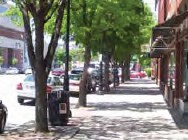 transportation, has encouraged city leaders to put more effort into accommodating and encouraging foot traffic throughout the city, especially in downtown and the adjacent commercial districts.
transportation, has encouraged city leaders to put more effort into accommodating and encouraging foot traffic throughout the city, especially in downtown and the adjacent commercial districts.
Consultants have advised that "young professionals" (the group most sought by city officials for their impact on city economic development) increasingly seek to avoid automobiles, and to use other forms of transportation, including walking.
A city "Pedestrian Plan" was developed recently, and can be seen here:
Pedestrian Master Plan -CoW 2015-02
The city has a
Bicycle and Pedestrian Advisory Board
(though to what extent it is made up of regular Bicyclists and Pedestrians -- or influenced by them -- is unclear).
Enclosed Elevated Walkways:
Elevated, enclosed, walkway bridges connect several buildings in Downtown Wichita, providing (theoretical) walking between buildings with little or no exposure to the often-harsh Wichita weather. However, their accessibility and status are of varying degrees -- some closed to all use, even sealed off.
Some consideration has been given to reopening some or all of them, as a part of the revitalization of downtown. However, required renovations can be quite costly, and it isn't always clear who pays for it. Building owners on either end of the bridge may have different attitudes and security needs. Further, the walkways are on different levels, requiring walkers to have access to multiple floors in most buildings (via elevators, stairs and/or escalators). These situations create great complications for property owners and, sometimes, for their tenants.
Downtown walkways include...
-
Douglas North Walkway
-- A string of walkways connect all buildings on the north side of Douglas from Water Street to Topeka Avenue -- a distance of four blocks -- crossing over Main Street, Market, and Broadway (and the alleys between them). This author has, on one occasion in the 1980s, walked that elevated route, from inside Intrust Bank to inside what was then Bank IV (now the Ruffin building), without ever setting foot outside. Since then, however, most of the walkways have been restricted or closed.
-
Waterman & Market Walkway
-- Another pair of elevated, enclosed walkways at Waterman and Market connect the State Office Building (formerly Innes/Macy's department store).and the Sutton Place office building to a city parking garage. The status of that walkway is uncertain as of 2016.
 Bicycle
Bicycle
Scientists, economists and environmentalists generally agree that, of all types of vehicles, bicycles are -- by far -- the most efficient, least polluting, and lowest in negative impact on cities.
Most Wichitans have had bicycles as children, but avoid them as adults. With Wichita's urban sprawl, foul weather, poor roadway accommodations for bicycles, and limited bikeways, and the very dangerous behavior of automobile and truck drivers towards bicyclists, bicycles are not safe, practical nor attractive transportation for most Wichita adults.
 However, bicycling is supported by a sizeable number of athletic and health-minded enthusiasts, and by parents who want to cycle with their children. Many of these are upper-middle-class and upper-class white people with political influence, or a passion sufficient to bring pressure to bear on City Hall.
However, bicycling is supported by a sizeable number of athletic and health-minded enthusiasts, and by parents who want to cycle with their children. Many of these are upper-middle-class and upper-class white people with political influence, or a passion sufficient to bring pressure to bear on City Hall.
Wichita city government has had periodic love-affairs with bicycling, driven largely by who sits on the City Council, but also by pressure from cyclists, cycling groups and bicycle-related businesses. Recent advice from city consultants has called for more "multi-modal" transportation -- including bicycles -- giving greater credence and impetus to the City's support of cyclists. The city has made various efforts, over the years, to accommodate bicycles, including:
-
Designating certain routes as "bike paths" (particularly "scenic" routes, incorporating both roadways and pedestrian walkways and bridges, as well as a few
 dedicated "bike paths" or mixed bicycle/pedestrian ways, particularly along the Arkansas Rivers and Canal Route) -- marking them with blue bicycle signs and distributing maps showing these routes.
dedicated "bike paths" or mixed bicycle/pedestrian ways, particularly along the Arkansas Rivers and Canal Route) -- marking them with blue bicycle signs and distributing maps showing these routes.
-
Adding bike stands suitable for parking and securing
bicycles at various locations around the city, particularly along bike paths and in the downtown and adjacent commercial districts, and at public buildings citywide.
-
 Mounting bicycle carriers on the fronts of city transit buses, and establishing protocols for their use.
Mounting bicycle carriers on the fronts of city transit buses, and establishing protocols for their use.
-
Recently, radically expanding the city's bike route system, with marked designated bicycle lanes on certain key streets.
The city has a
Bicycle and Pedestrian Advisory Board
(though to what extent it is made up of regular Bicyclists and Pedestrians -- or influenced by them -- is unclear).
For more on the City's bike accommodations, rules, and plans, and a map of bike routes, see these pages on the City of Wichita official website:
Another Bright Idea for Cycling
Another factor enhancing bicycling, recently, has been the development of cheap, simple, lightweight, compact, low-power, bright, durable and long-lasting LED-based bicycle lights -- radically improving the affordability and reliability of bicycle lighting, and resulting visibility and safety for bicyclists, giving people greater confidence in bicycle safety and utility -- and apparently contributing to an increase in nighttime cycling.
The Most Critical Use of Bicycles
While the bicyclists who influence the City are predominantly upscale people, riding chiefly for pleasure, the predominant adult users of bicycles in Wichita are the poor -- who use them as the only vehicles affordable to them for essential transportation. For the poor, bicycles are less expensive to use than any other form of
transportation, except walking.

They are cheaper (by far) than local mass transit -- let alone taxi service -- and far more flexible in routes and destinations, and operate without the requirement to wait for transportation to arrive. There are no costly insurance requirements, and licensing (though legally required) is seldom done.
Bicycles have an additional crucial value to the poor: They provide escape from danger -- whether outrunning other poor people attempting robbery or other crimes, or used for evading capture when a poor cyclist is committing a crime, themselves. For criminal activity, bicycles also accommodate quick or slow, and invasive, travel (allowing scouting of targets of opportunity).
In the poorest areas, particularly along Wichita's Broadway corridor ("skid row"), where the poorest and most criminal poor predominate (particularly drug addicts and the mentally disabled), bicycles are heavily used, frequently sold and traded, and the object of frequent theft. One national urban criminologist refers to bicycles as "currency" in poor communities.
 However, it should be noted that the VAST majority of the poor only use bicycles for legitimate purposes -- as their only means of basic and essential vehicular transportation.
However, it should be noted that the VAST majority of the poor only use bicycles for legitimate purposes -- as their only means of basic and essential vehicular transportation.
Bicycles are crucial to providing employment opportunities for the poor, by radically expanding the range they can travel to find and attend work and legitimately acquire other resources (including food and healthcare).
For a comparison, consider that a person walking at 4mph along Wichita's street grid has a theoretical "reach" (the land area within their reach, from which they can choose destinations within an hour's travel) of 32 square miles, whereas a bicyclist at 12mph (a typical speed) has a theoretical reach of 288 square miles -- NINE times as many possible destinations within an hour's reach. The diversity of economic opportunity varies accordingly, for a poor person with a bicycle.
Because of a lack of recent personal experience with urban poverty, and a lack of engagement with Wichita's poor, few of the people in city government engaged with bicycle issues have any real grasp of the way in which bicycles are most used by adults in Wichita -- and thus form city bicycle policies and practices around the desires and resources of more upscale cyclists, for whom bicycling is a lifestyle choice, rather than a critical necessity.
Special Bicycles
Other vehicles that are variations on bicycles, which tend to be operated and regulated about the same way as regular bicycles, include adult tricycles (made from adult bicycle components, often fitted with large baskets for utility uses), and tricycle food carts (essentially "backwards tricycles" with a special (usually insulated) box between the front two wheels, for ice cream and hot-dog vendors). Both types of vehicles are found on Wichita streets, particularly in fair weather.
UPDATE, 2019:
CITY BIKES: As part of its attempts to "revitalize" inner-city Wichita (particularly downtown, and the adjacent Old Town and Delano shopping/entertainment districts), the City of Wichita has undertaken a project to distrubute bicycles scooters at city bike stands throughout those areas. The bikes are locked up, electrically, but can be operated by anyone with a smartphone and a credit card or debit card. They can use the smartphone app to communicate their card info to a central clearinghouse, which then -- by remote control -- "unlocks" and the bike and enables it to be operated by the renter. The renter can then discard the bike anywhere in the area,.
For other types of cycles, see Motorcycle or Special Vehicles sections below.
 Motorcycle
Motorcycle
Motorcycling is a fairly inexpensive, and exhilirating, form of travel -- but dangerous and generally uncomfortable, especially in Wichita's harsh weather. Wichita is a challenging environment for motorcyclists, offering good highways, but sloppy, indifferent automobile and truck drivers who frequently turn in front of moving motorcycles, often with fatal consequences.
Kansas motorcycle laws are farily lax, requiring only that the driver wear approved eyewear or eye protection, to avoid "bugs in they eyes" resulting in accidents. Helmets are not required, except for minors.
Motor-Scooters and Mopeds
Small, comparatively slow, low-powered, motor-scooters and mopeds (a hybrid of bicycle and motor-scooter, which can be powered by motor or pedals) are not allowed on limiited-access U.S. or Interstate Highways, so are not permitted on the city's main east-west route (Kellogg) nor on the city's other major highways (I-135, I-235, K-96, and certain sections of K-15 and K-42).
However, motor-scooters and mopeds have other advantages, including the lowest purchase price of motorized vehicles, no insurance requirements, cheap tags, and no requirement for a valid driver's license (at least in the case of mopeds. In addition to various other advantages this offers, the option to drive without a license provides a way for people with revoked drivers' licenses, especially those with health or substance-abuse issues, to be abe to drive without posing a major risk to the public (this implictly reduces drunk-driving fatalities of innocent others). Additionally, many places accommodate sidewalk parking of scooters and mopeds. And, among practical motor vehicles, their fuel mileage and cost of operation are unbeatable.
Electric Scooter
Electric-powered scooters -- similar to toy scooters used by children -- are becoming, nationwide, a popular urban vehicle, especially for young adults.
UPDATE, 2019:
As part of its attempts to "revitalize" downtown Wichita, and the adjacent Old Town and Delano shopping/entertainment districts, the City of Wichita has undertaken a project to distrubute electric-powered scooters at scooter stands throughout those areas. The scooters can be operated by anyone with a smartphone and a credit card or debit card. They can use the smartphone app to communicate their card info to a central clearinghouse, which then -- by remote control -- "unlocks" the scooter, and enables it to be operated by the renter. The renter, when finished, can then discard the scooter anywhere in the area, and -- later -- a city vendor's pickup vehicle goes around and gathers up the scooters, and redistributes them to the scooter stands throughout the area. The program has had mixed reviews: It's popular with users, and with some businesses who appreciate car-less customers visiting their stores, which are often without doorside parking. Some object to the safety hazards that scooter operators (seldom wearing helmets or any other protective gear, usually operating without any safety training, or prior scooter experience, and extremely vulnerable to weather and other vehicles) present to themselves and others. Objections have been raised to renters driving the scooters illegally (on sidewalks, through red lights, etc.) and abandoning the scooters in inappropriate places, leaving them like scattered junk littering the area.
 Automobile
Automobile
By far, the personal automobile (coupes & sedans, but also convertibles, station wagons, mini-vans, vans, SUVs, pickup trucks, and recreational vehicles) is the preferred method of transportation for the vast majority of Wichitans. The city's weather, vast urban sprawl, adequate roadways, low traffic density, ample parking, and low cost of vehicle ownership and operation are all contributing factors.
By comparison to the hour-long commutes common by bus, automobile operators in Wichita mostly commute to work within 20 minutes.
In fact, automobiles are so popular in Wichita that it was statistically reported in the mid-1970s that Wichita had the highest ratio of cars-per-people of any major city in the United States.

Wichita apparently continues to use the automobile at a higher-than-average rate for major U.S. cities.
RENTALS: Local facilities of most major national vehicle-rental services (mostly based at Wichita's Eisenhower Airport), and some locally-based services, provide automobiles, mini-vans, vans, trucks (including moving vans) and trailers.
More on this topic will be provided in an upcoming enhancement of this site.
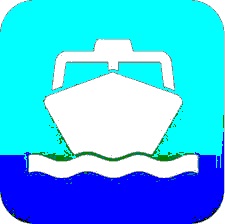 Boating
Boating
Boating, within the city limits, is very limited, and only used for recreation.
Though the Arkansas River is navigable by barge and riverboat from the Mississippi River to near Tulsa (since the 1970s), local. state, and federal authorities decided not to extend the shipping lanes all the way to Wichita. Global warming and subsequent drought -- often exposing the riverbed -- have vindicated their decision.
Some small private lakes within the city accommodate various types of boating for residents of adjoining properties, however none are open to the public. The nearest lake allowing public boating is Lake Afton, in southwest Sedgwick County, or Cheney Lake extending west of the Sedgwick County's northwest corner, or Santa Fe Lake, to the east, in adjoing Butler County.
In south Wichita's O.J. Watson Park, a public facility operated by the City of Wichita's Parks and Recreation Dept., pedal-powered paddle boats can be rented for paddling around the small, complex lake, during the summer. Personal boats are not allowed.
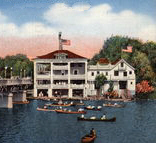 The Riverside Boathouse
The Riverside Boathouse
For eight decades, between 1888 and 1968, boating on the Little Arkansas River, through Riverside Park, was a very popular pastime. It was an extraordinarly popular public pastime for energetic young people, romantic couples, families, and even the elderly.
What made it practical and popular was the giant, 4-story "Riverside Boathouse" (originally the "Israel Boathouse") at Murdock and the River -- a family business adjacent to the Murdock Bridge. The boathouse became, for over three-quarters of a century, one of the city's most popular warm-weather recreation centers -- a commercial enterprise where customers could rent john-boats (flat-bottomed rowboats), aluminum canoes, or pedal-powered paddle boats, for an excursion up and down the river, through the winding, tree-shaded channels in Riverside Park.
For more on the history of the old and new boathouses, see:
...and these excerpts from Prof. Edward Tihen's index of Wichita Eagle articles ("The Tihen Notes"):
-
The Wichita Eagle, Wednesday, July 12, 1916
page 21, article reporting that between 2,000 and 3,000 people were estimated to have attended the annual opening of the Riverside boathouse, at the foot of Murdock avenue, the previous evening.
-
The Wichita Eagle, Saturday, June 1, 1963, page 5A. detailed article, with photo, reporting that the Riverside boathouse will be one of the first properties acquired for the Park Plaza Urban Renewal project. The option to sell the land and property was returned, the day before, to the agency office by Ralph B. Foster, 5102 East Pine, then-current owner of the boathouse. The boathouse had a river frontage of 75 feet and the property line ran to the center of the river.
-
The Wichita Eagle, Sunday, February 6, 1966,
page 1D. detailed article, with photo, reporting that the days of the Riverside boathouse were numbered. It was to be razed as part of the Park Plaza Urban Renewal project.
|
For various reasons -- despite passionate pleas from the community for its preservation and restoration -- the Riverside Boathouse was demolished in 1968, and never rebuilt.
The New (Downtown) Boathouse
Rather than work with the family that had run the successful Riverside Boathouse, the City half-heartedly attempted to re-institute, on its own, the popularity of the Boathouse -- by building an elegant modern structure on the broad, straight, barren banks of Arkansas River downtown -- between the Kellogg overpass and Lewis Street Bridge, on the East Bank (see photos below).

The building included a grandiose decoration: the famous "Americas 3" racing yacht (former winner of the prestigious America's Cup, and owned and captained by former Wichita billionaire Bill Koch), and the interior of the building contained a "shrine" of sorts to the boat. That playboy, the youngest Koch brother, donated $1 million to build the boathouse (another $300,000 was raised from other donors).
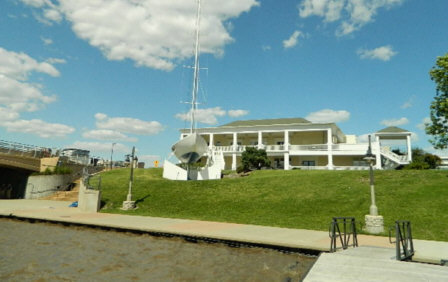 However, the New Boathouse, downtown, was in no way a substitute for the Riverside Park original. Its location is on a bland, straight slab of the river, with a hazardously strong current, and near to the dangerous Lincoln Street dam (commonly needed to keep that section of the river deep enough for boating).
However, the New Boathouse, downtown, was in no way a substitute for the Riverside Park original. Its location is on a bland, straight slab of the river, with a hazardously strong current, and near to the dangerous Lincoln Street dam (commonly needed to keep that section of the river deep enough for boating).
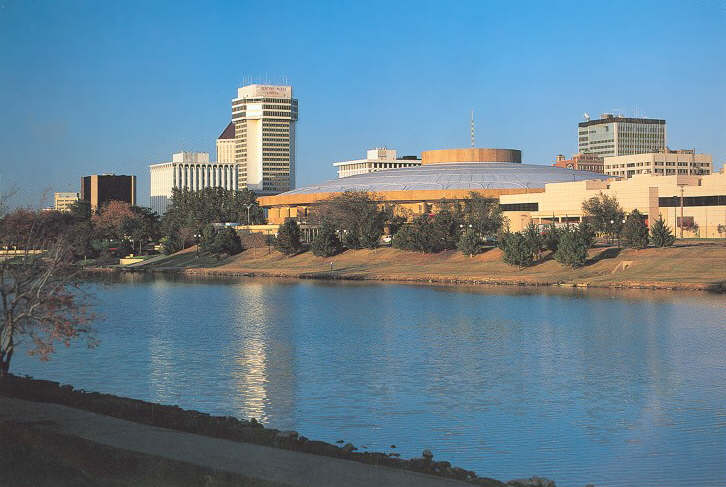
That area was very unattractive (and even dangerous) for recreational boaters. While the original Riverside boathouse visitors communed with Nature on the gentle, winding, tree-lined creek (the Little Arkansas River) in Riverside Park, today's new downtown boathouse sits on a broad, straight expanse of rushing, open water. The view on either side is a mostly barren bank -- on one side backed by the local baseball stadium, and on the other by downtown Wichita.
The water echoes with the noise of traffic from the nearby highway (Kellogg) overpass crossing the river, and the river boulevard (McClean) along the west bank, and the string of downtown bridges immediately to the north. Hardly a peaceful setting, nor romantic, nor even safe for the elderly or families with children.
With the emerging drought effects of global warming, the broad, shallow, Arkansas riverbed -- through downtown, and especially south of the Lincoln Street dam -- is, quite often, nearly dry and simply unsable by any kind of boat. At other times, the downtown riverbed's shifting sandbars create hazards for boats, and when the water is too deep for the sandbars to be hazard, it is typically because of flood-like waters raising the river into a rushing torrent far too hazardous for boating.
Further, the New Boathouse was never really equipped for recreational boating. Dock and storage facilities were hopelessly inadeqate, and the city could never get an operator that they could (or would) work with, to provide real boating opportunities for the public.
At various times over the years, the New Boathouse would be the site for occasional attempts to invite the public for short boating experiences on the adjacent stretch of river -- events erratically sponsored by various groups, often with poor provisions for public safety.
But the public and boating enthusiasts alike found little to like in the boring, wide-open, treeless, rectangular river section (resembling a simple rectangular pond), the swift waters. and the danger of the nearby downstream dam (which often malfunctioned, sometimes emptying the downtown riverbed).
Various tenants have promised to make something of the Boathouse. None have ever succeeded. The same is true of the adjacent "Gander Mountain" outdoor-products store, which briefly toyed with providing rented kayaks for riverfront boating.
RiverFest: The Wichita River Festival
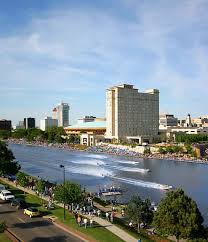 The Wichita community's biggest annual event is RiverFest: The Wichita River Festival -- that takes place every Spring along the banks of the Arkansas River, and throughout its downtown surroundings. Starting in the 1970s, seeking to capitalize on the scenic, renovated riverbanks, community leaders organized a week-long party along the river -- with music, dancing, races, exhibitions, fireworks and other events.
The Wichita community's biggest annual event is RiverFest: The Wichita River Festival -- that takes place every Spring along the banks of the Arkansas River, and throughout its downtown surroundings. Starting in the 1970s, seeking to capitalize on the scenic, renovated riverbanks, community leaders organized a week-long party along the river -- with music, dancing, races, exhibitions, fireworks and other events.
RiverFest became an enormous hit with the community and among the events that attracted the most attention were events on the river, itself -- including exhibition skiing and boat races, like athletic sculling, and the comical "bathtub races" (more a parade of wildly decorated floating tubs). Subsequent commercial and civic development along the East bank of the Arkansas River has limited and dampened public access to the main section of the River traditionally used as the site of the RiverFest. Partly as a consequence, RiverFest has declined in river-front events and public popularity.
RiverFest was (and, to some extent, still is) the only time -- since the 1970s -- when any conspicuous boating has happened on the Arkansas River.
The Current State of Boating on the River
Today, normally vacant, the costly New Boathouse, under City government ownership, serves chiefly as an occasional business meeting site, and as a party venue for the community's wealthy.
When the Gander Mountain company wanted to open a sporting goods superstore in Wichita, they selected a site immediately south of the New Boathouse, in purported hopes of using the river, as well. With much support and fanfare from the City, the business opened, but did not do much with boats. Their boating effort has apparently mostly failed, as well. UPDATE: Early 2017: Gander Mountain's parent company filed for bankruptcy, and has closed all its stores.
Motor-boating and sailing on the Arkansas river, once common, is now non-existent. It is unclear who has responsibility for governing use of the river, but the City shows no enthusiasm for promoting its use for recreational boating.
Dams at the confluence of the rivers (just northwest of Downtown), and at Lincoln Street (just south of Downtown), help maintain water depth, but also create hazards to navigation. The Lincoln Street dam features a "water ladder" bypass for kayaks, but it is tricky to use, and not suitable for other boats.
Additionally, the Lincoln Street Dam is adjustable, and is frequently lowered -- sometimes nearly emptying the riverbed upstream, and flooding it downstream, complicating boating opportunities. Further, little or no advance public notice is given of such changes in the river, making planned boating activity next to impossible, or (at best) a game of chance.
According to the City of Wichita's website, in the Parks & Recreation Dept. section on "Fishing & Boating", there are three sections of the river that may be used for boating, and they are:
- Non-powered craft:
At no charge, such craft may be operated on the Big Arkansas River between the upstream "Amidon/Meridian Bridge" (apparently south of 21st & Amidon - Twin Lakes Shopping Center) in northwest Wichita, and the downstream Lincoln Street Dam & Bridge, in south-central Wichita.
(No mention is made of boating on the Little Arkansas River).
Non-motorized craft must stay 50 feet away from the hazardous "Falls Area" at the confluence of the Big and Little Arkansas Rivers., north of the 1st Street / 2nd Street Bridge.
- Powered craft:
For a $7.50/day permit (obtained from the City, and required to be carried while on the river), such craft may operate in these areas:
- Between the upstream Lewis Street Bridge (downtown), and the downstream Kellogg Overpass Bridge (downtown) -- the "boat ramp area" (a distance of about a quarter of a mile) -- at 5 mph or less.
- Between the upstream Kellogg Overpass Bridge (downtown), and the and the downstream Lincoln Street Dam (south-central Wichita) -- a distance of about half a mile -- at 40 mph or less.
All boats must stay 150 feet from the (very dangerous) Lincoln Street Dam.
 However, a kayak "ladder" -- a sort of water-slide for kayakers -- a channel bypassing the Lincoln Street Dam, down a shallow, narrow spillway -- allows kayakers to more-or-less safely paddle around the dam, when heading downstream (water levels permitting).
However, a kayak "ladder" -- a sort of water-slide for kayakers -- a channel bypassing the Lincoln Street Dam, down a shallow, narrow spillway -- allows kayakers to more-or-less safely paddle around the dam, when heading downstream (water levels permitting).
The Ark River Coalition (ARC) --
a group of paddle-sportsmen and civic advocates for the preservation, protection and recreational utilization of the River -- conducts occasional "floats" on the river: group boating expeditions for all interested people in kayaks and canoes -- including occassional events for beginners; kayaking classes are taught by the Wichita Parks & Recreation Department, and kayaks can be rented from Gander Mountain Sports, next to the New Boathouse. UPDATE: Early 2017: Gander Mountain's parent company filed for bankruptcy, and has closed all its stores.
For more on use of the Arkansas River in Wichita, see the City of Wichita's website, in the Parks & Recreation Dept. section, on "Fishing & Boating" page.
Local Creeks and Streams
Wichita's other creeks are generally unsafe for boating, owing to narrow, shallow channels often with sandbars, snags, low bridges, culverts and other obstacles, and unpredictable depths and currents. They largely run through private property, and are considered a part of the adjacent landowner's property, and hence out-of-bounds (also true of much of the Little Arkansas River).
Boating on Local Lakes
Several small sand-pit lakes, some over a square mile in size and suitable for boating, dot the Wichita landscape, especially south and west -- mostly leftovers from ancient channel changes of the Arkansas River and its tributaries.
Though nearly all are private property, the lake at O.J. Watson Park in South-Central Wichita -- immediately southwest of the Arkansas River, on McClean Boulevard, south of Pawnee -- is in a public park. During warm months, the Park offers inexpensive rental of canoes and paddle-boats for human-powered puttering around the horseshoe lake in the park, but does not allow private boats. (Pony rides for children and miniature train rides through the park are also offered affordably).
Two other lakes in Sedgwick County, and two in neighboring Butler County to the east, offer a fuller range of boating opportunities:
Lake Afton Tree-lined, meandering Lake Afton is in southwest Sedgwick County. Boating, fishing, swimming, nice picnic park.
Cheney Reservoir ("Lake Cheney"), much larger, in the northwest corner of the county, spreads west into adjacent counties. At Cheney, motorboating and sailboating are common, as is boat fishing.
Santa Fe Lake near Augusta, 20 minutes to the east, is popular with sailboats.
El Dorado Lake, 45 minutes to the east, is a massive, recent reservoir, dotted with old tree lines in the water, and occasional bald eagles.
Boating across Kansas
Several boating lakes (mostly large reservoirs) are available throughout Kansas, including Fall River and Toronto, a couple of hours' drive east. Others exist as well. Water condition is occasionally unhealthy, but usually safe.
Kansas rivers are generally unreliable and/or unsafe for boating, and sometimes too polluted for recreation.
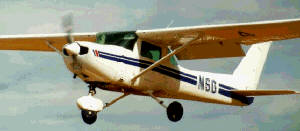 Personal Aviation
Personal Aviation
(see
AVIATION
, on the MORE page)
Note that "personal transportation" also includes, technically, personal watercraft (typically boats), and personal aircraft -- though these are not normal modes for travel within Wichita; however, they do find occasional local use on waterways and airways over the city. And personal aviation -- for inter-city travel and recreation -- has a noticeable impact on overall transportation planning and accommodations in Wichita. Accordingly all of these are detailed here.
 Special Vehicles
Special Vehicles
There are several other "special" modes of "personal transportation" not widely used for transportation in the conventional sense, but nevertheless well worth noting.
Some of these are frequent hazards when encountered on Wichita's roadways -- and some more often than others (particularly in certain neighborhoods), including some which are on the increase.
"Special vehicles," as defined here, include (but are not limited to):
- Horses & Horse-drawn Wagons
- Wheelchairs & Motorized Wheelchairs
- Youth-Oriented Transportation:
- Roller Skates, Skateboards & Hoverboards
- Tricycles
- Motorized Toy Cars
- Scooters
- Motorized Scooters (Electric or Gasoline)
- Mini-bikes (minature motorcycles)
- Go-Karts & Midget Cars
- Golf Carts & Courtesy Carts
- Cushman Carts (enclosed "meter-maid" motor-scooter trikes)
- Utility & All-Terrain Vehicles (ATVs)
- Riding Lawn-mowers and Lawn Tractors
- Tractors & Farm Machinery
- Construction, Road-Maintenance & Material-Handling Equipment
(e.g.: Bulldozers, Skip-Loaders, Road-Graders, Street-Sweepers, Cranes, Fork-lifts, etc.)
LOOK OUT !
WICHITANS ARE ON THE MOVE !
Participate - Let your voice be heard!